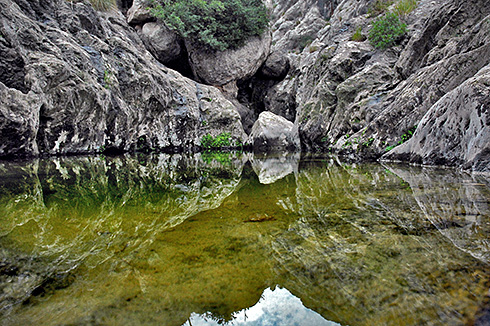The cinereous vulture and mallorcan midwife toad
One of the Serra de Tramuntana's main assets, from a biological perspective, is the conservation of certain species of animals, which have come to acquire symbolic importance. Firstly, there is the Mallorcan midwife toad: a small toad that mainly lives in the most inaccessible parts of the Serra de Tramuntana's torrents. Secondly, there is the cinereous or black vulture, the largest bird of prey in Europe. Both are protected species, considered, just a few decades ago, to be extinct in the case of the cinereous vulture or not even known in the case of the toad. From the second half of the 1980s and early 90s, programmes to restore and protect populations of both species were developed by the Government of the Balearic Islands and by different nature protection associations.
The Black Vulture Conservation Foundation (BVCF) was created in Holland in 1986. It has its headquarters in Spain in Mallorca, at Son Pons rural estate in the municipality of Campanet. Since 1986, the foundation has developed different programmes to conserve the cinereous vulture (Aegypius monachus) in close collaboration with the Government of the Balearic Islands, other ecologist associations, local bodies, and different volunteers, and with the support of the European Union. Among its different activities, action has been taken to reduce threats to the vultures and to safeguard and protect their territories, together with environmental education activities, a programme to rear these vultures in captivity and projects to release them back into the wild to reintroduce or reinforce populations of vultures throughout Europe.
The cinereous vulture is quite different from the common vulture. It can have a length of up to 110 cm and wingspan reaching 296 cm
The BVCF started operating in Mallorca in 1986 with a programme to conserve the cinereous vulture on the island and another to rear vultures in captivity in order to reintroduce new vultures to existing colonies. In the 1990s, in addition to its initial activities, a programme was introduced to eradicate the use of illegal poisons in Mallorca, since one of the big dangers is when vultures eat poisoned carrion. In more recent years, its work has taken a more global perspective, because the conservation of the cinereous vulture goes hand in hand with promoting the continuance of sustainable farming activities. This problem - the abandonment of traditional agricultural and livestock land uses by farmers in the Serra de Tramuntana - is one of the most persistent threats for the cinereous vulture and, in general, for the biodiversity of the Serra.
The cinereous vulture is quite different from the common vulture. It can have a length of up to 110 cm and wingspan reaching 296 cm. Its wings are more uniform in width, its tail is wedge-shaped, and it is dark in colour. It rears its young in small, scattered colonies, in big tree branches. It feeds on carrion and can perforate skin and tendons with its powerful beak.

The Mallorcan midwife toad (Alytes muletensis) was not described until 1981. Indeed it was initially only known as a fossil when one was discovered in 1978 in a cave called Cova de la Muleta in Sóller
The Mallorcan midwife toad (Alytes muletensis) was not described until 1981. Indeed, it was initially only known as a fossil when one was discovered in 1978 in a cave called Cova de la Muleta in Sóller.At this archaeological site, the oldest Balearic human remains have been found (dating back some 5,000 years), together with the bones of extinct mammals like Myotragus balearicus. In 1981, the last living examples of this native species were discovered (native just to Mallorca). Today the Mallorcan midwife toad has been conserved thanks to a programme to restore the population, sponsored by the Government of the Balearic Islands since 1991 in collaboration with ecologist groups like the Associació per a la Recuperació del Ferreret.
The Mallorcan midwife toad did not die out because it has a unique, very limited biotope: torrents that only carry water intermittently, in places that are hard for man to reach. They comprise karstic formations of two types: torrents that have carved out very narrow gorges, and isolated spots with water in open areas of the mountains. The Mallorcan midwife toad climbs vertical walls and shelters in crevices and holes in the rocks. Its inaccessible habitat has protected the toad from man and from other vertebrates introduced by man. The construction of reservoirs and the contamination of torrents led to a reduction in the number of Mallorcan midwife toads. Despite conservation programmes, they continue to have numerous 'enemies', including droughts, contaminated torrents, people who try to steal them, and infections.
Text by Jordi Martí
Translated by Rachel Waters
Did you know that...
The Mallorcan midwife toad is a great climber, as this is the only efficient means of getting about in the habitat in which it lives. It does not live in any part of a torrent. It always chooses the most inaccessible, boxed in or steep gorges with vertical walls. This is the secret of its survival.
The cinereous vulture is also very sensitive to man's presence. When man is too close, it can abandon its nest or have serious problems feeding. It is very solitary, although it gathers in small groups to eat. It flies at a very high altitude of up to 110 metres, taking advantage of currents of air.
Bibliography
Numerous scientific publications can be found about the cinereous vulture and Mallorcan midwife toad, a large part in the form of articles published in different specialist journals or as internal reports for different bodies and institutions involved in the conservation of both species.
A pioneering article about the cinereous vulture is "Contribución al conocimiento del buitre negro, Aegyptus monachus, en Mallorca" by J. Mayol, published in 1977 in the Boletín de la Sociedad de Historia Natural de Baleares. More recent articles include one by Evelyn Tewes entitled "El programa de conservació del voltor negre, Aegyptus Monachus, a Mallorca", published in Anuari Ornitològic de les Balears in 2002 (p. 59-69), and a report by J.J. Sánchez entitled "Impacto del uso ilegal de veneno en Baleares y acciones en marcha para su control", presented at the 3rd edition of the Balearic Environmental Symposium (2001).
In the case of the Mallorcan midwife toad, a pioneering article was "Espècies relíquies d'amfibis i de rèptils a les Balears i Pitiüses" by J.A. Alcover and J. Mayol, published in issue no. 25 of the Bolletí de la Societat d'Història Natural de les Balears in 1981. A more recent contribution is an article by Álvaro Román entitled "El ferreret, la gestión de una especie en estado crítico", published in the magazine Munibe in San Sebastián in 2003 (p. 90-99).




